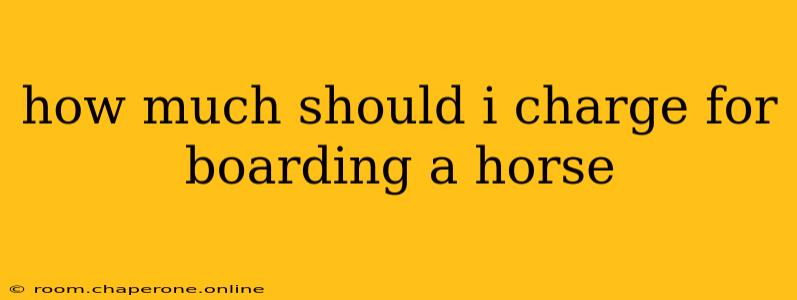How Much Should I Charge for Boarding a Horse? A Comprehensive Guide
Boarding horses can be a rewarding venture, but setting the right price is crucial for profitability and maintaining positive client relationships. Many factors influence the ideal boarding fee, and understanding these will help you establish a fair and competitive rate. This guide delves into the key considerations to determine how much you should charge for boarding a horse.
Understanding Your Costs: The Foundation of Pricing
Before setting your rates, meticulously calculate all your expenses. These fall into several categories:
1. Infrastructure & Facility Costs:
- Property Taxes & Insurance: These are significant annual costs. Factor in property taxes, liability insurance (crucial for protecting yourself from potential accidents), and any other insurance policies.
- Facility Maintenance & Repairs: Regular upkeep is essential. Include costs for fence repair, barn maintenance, stall cleaning supplies, and potential larger repairs like roof work or drainage improvements.
- Utilities: Electricity, water, and potentially heating and cooling costs add up. Consider seasonal variations in utility bills.
2. Labor Costs:
- Your Time & Effort: This is often overlooked. Account for the hours you spend daily on chores, feeding, managing the property, and interacting with clients. Assign a reasonable hourly rate to your labor.
- Employee Wages (if applicable): If you employ staff, their salaries and benefits are significant expenses.
3. Feed & Supplies:
- Hay & Grain: The cost of feeding horses is highly variable depending on location, hay quality, and quantity required per horse. This is often a significant portion of your overall costs.
- Supplements & Medications: Consider whether you provide supplements or medication as part of your boarding package.
- Bedding: Straw, shavings, or other bedding materials add to your expenses.
4. Other Expenses:
- Veterinary & Farrier Care (if included): If you offer access to vets and farriers, or include their services in your packages, factor in the cost or potential discounts you can negotiate.
- Marketing & Advertising: The cost of attracting boarders through advertising or website maintenance.
- Legal & Accounting: Include fees for legal consultations and accounting services.
Analyzing Your Market: Competitive Pricing & Value
Once you understand your costs, research your local market. Visit competing boarding facilities and inquire about their rates. This will give you a benchmark.
Consider the following factors when comparing:
- Type of Boarding: Full-board (includes everything), pasture board (basic grazing), self-care board (owner handles most care), or other options. The services included directly affect pricing.
- Amenities: Do you offer a riding arena, round pen, wash stall, tack room, trails, or other amenities? These increase the value (and price) of your boarding services.
- Location: Boarding facilities in desirable or convenient locations may command higher rates.
- Target Market: Are you aiming for a luxury market or a budget-conscious clientele? This will influence your pricing strategy.
Pricing Strategies: Finding the Sweet Spot
Several pricing strategies can work:
- Cost-Plus Pricing: Calculate your total costs and add a markup percentage for profit. This is a simple method, but ensure your markup is competitive.
- Value-Based Pricing: Focus on the value you offer. Superior facilities, personalized care, or unique amenities justify higher prices.
- Competitive Pricing: Set your prices slightly below or in line with competitors. This can attract boarders, especially when starting out.
Setting Your Rates: A Practical Approach
To determine your rates, create a detailed spreadsheet outlining all your expenses and projected income. Experiment with different markup percentages to find a profitable yet competitive price point. Remember to account for potential vacancy periods and seasonal fluctuations.
For example:
- Cost of goods and services: $5000 per month
- Desired profit margin: 20%
- Monthly revenue target: $6000 ($5000 / 0.80 = $6250)
- Number of boarding stalls: 5
- Approximate cost per stall per month: $1250
Always clearly outline your services and charges in a written agreement with each boarder, to prevent misunderstandings and disagreements.
By thoroughly analyzing your costs, understanding your market, and employing a well-considered pricing strategy, you can establish a fair and successful horse boarding business. Remember, building strong client relationships is just as important as setting a profitable rate.

